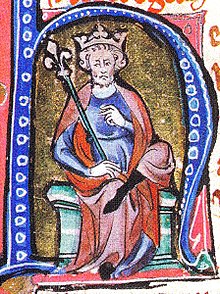King Canute
| Cnut the Great | |
|---|---|

A 14th century portrait of Cnut the Great
|
|
| King of England | |
| Reign | 1016-35 |
| Coronation | 6 January 1017 in Old St Paul's Cathedral, London, England |
| Predecessor | Edmund Ironside |
| Successor | Harold Harefoot |
| King of Denmark | |
| Reign | 1018-35 |
| Predecessor | Harald II |
| Successor | Harthacnut |
| King of Norway | |
| Reign | 1028-35 |
| Predecessor | St Olaf II |
| Successor | Magnus the Good |
| Born | c. 995 Denmark |
| Died | 12 November 1035 (aged 40) Shaftesbury, Dorset, England |
| Burial | Old Minster, Winchester, England. Bones now in Winchester Cathedral, Winchester, England |
| Spouse | |
| Issue |
|
| House | Denmark |
| Father | Sweyn Forkbeard |
| Mother | unknown (Świętosława / Sigrid/ Gunhild) |
| Religion | Catholic |
King Cnut the Great (Old Norse: Knútr inn ríki;c. 995 – 12 November 1035), also known as Canute, was King of Denmark, England, and Norway, together often referred to as the Anglo-Scandinavian or North Sea Empire. After his death, the deaths of his heirs within a decade, and the Norman conquest of England in 1066, his legacy was mostly forgotten. The medieval historian Norman Cantor stated that he was "the most effective king in Anglo-Saxon history", although Cnut himself was Danish and not a Briton or Anglo-Saxon.
Cnut is popularly invoked in the context of the legend of King Canute and the waves, but usually misrepresents Cnut as a deluded monarch believing he has supernatural powers, when the original legend in fact states the opposite and portrays a wise king.
Cnut's father was Sweyn Forkbeard, King of Denmark (which gave Cnut the patronym Sweynsson, Old Norse Sveinsson). The identity of his mother is uncertain, although medieval tradition makes her a daughter of Mieszko I. As a Danish prince, Cnut won the throne of England in 1016 in the wake of centuries of Viking activity in northwestern Europe. His accession to the Danish throne in 1018 brought the crowns of England and Denmark together. Cnut maintained his power by uniting Danes and English under cultural bonds of wealth and custom, as well as by sheer brutality. After a decade of conflict with opponents in Scandinavia, Cnut claimed the crown of Norway in Trondheim in 1028. The Swedish city Sigtuna was held by Cnut. He had coins struck there that called him king, but there is no narrative record of his occupation.
...
Wikipedia
